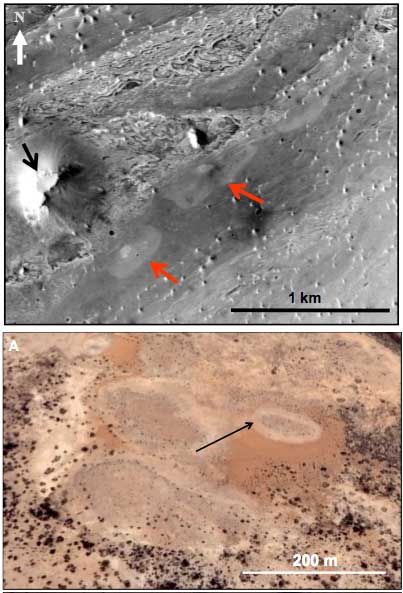More Details Emerge on Possible Mars Hot Springs

Mounds onMars that could be from ancient hot springs are described in a new study, aftersetting the astrobiology community abuzz last spring.
Hydrothermalsprings on Earth, like those in Yellowstone National Park, harbor whatscientists figure are the closest relatives to the original organisms thatlived on our planet. Finding these features on Mars (or any other planet) couldhave big implications for the questionof extraterrestrial life.
Mars hasmany features that suggest the planet was once warmer and wetter. At the least,the ancient vents ? if that's what they are ? would make great places to lookfor signs of past life.
The featuresfound on Mars, imaged on the edge of the Arabia Terra region by NASA's MarsReconnaissance Orbiter's High Resolution Imaging Science Experiment (HiRISE),have "proved to be a very close match" to hydrothermal springs onEarth, said study co-author Carlton Allen, of NASA's Johnson Space Center in Houston.
Thefindings, announced today, are detailed in the new issue of the journal Astrobiology,and were presentedlast April.
The shapesof the mounds and the channels that flow away from them are similar to thoseseen in the hot spring areas of Yellowstone, Allen told SPACE.com today.They are situated in a deep crater with steep slope and could have been fed byunderground water sources on ancient Mars, which is thought to have beenconsiderably wetter than its present-day incarnation, he added.
But Allenand his co-author Dorothy Oehler, also of Johnson Space Center, can't confirm forsure the features' provenance because they don't know what they're made of.
Breaking space news, the latest updates on rocket launches, skywatching events and more!
"Thething that we don't have is compositional data," Allen said.
The areasaround hot springs on Earth have particular mineral make-ups, and findingsimilar signatures on Mars would likely clinch the finding. MRO's CRISMinstrument could detect this signature except for one problem: Mars' ubiquitouslayer of dust.
"There'sjust enough dust to obscure the spectral features," Allen said. "Sowe are stymied as far as getting compositions on these particularfeatures."
But ifsimilar mounds could be found in less dust-covered areas, spectra could betaken and the long-standing question of whether Mars once harbored hot springs (and by extension, possibly life) could be answered.
"Peoplehave been looking for evidence of spring on Mars for an awfully longtime," Allen said.
Spectralfeatures that could have been produced by hot springs have been found on Mars,such as by the Spirit rover in the Columbia Hills, but no obvious correspondingsources have been found.
Allen hopesthat the features he and Oehler found will serve as "a template" forothers to search images of Mars. He and Oehler conducted such a search ofthousands of images this summer, but didn't turn up any more features.
They seem"to be a fairly rare phenomena," Allen said. Though there is thepossibility that they once covered the surface, but were subsequently coveredup or destroyed by erosion and volcanism, he said.
- VIDEO ? Looking For Life in All the Right Places
- VIDEO ? Mars Reconnaissance Orbiter
- The Big Picture: Astrobiology

Andrea Thompson is an associate editor at Scientific American, where she covers sustainability, energy and the environment. Prior to that, she was a senior writer covering climate science at Climate Central and a reporter and editor at Live Science, where she primarily covered Earth science and the environment. She holds a graduate degree in science health and environmental reporting from New York University, as well as a bachelor of science and and masters of science in atmospheric chemistry from the Georgia Institute of Technology.
